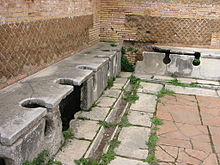- Latrine
-
A latrine is a communal facility containing one or more commonly many toilets[1] which may be simple pit toilets or in the case of the United States Armed Forces (or more specifically, the US Army and US air force) any toilet including modern flush toilets. The term is derived from the Latin lavatrina meaning bath.
Types
Roman public latrinae found in the excavations of Ostia Antica. Unlike in the modern installations, the Romans felt no need to provide privacy to each individual user.
Many forms of latrine technology have been used in the past, from utterly simple to more sophisticated, while newer developments show promise using ecological sanitation (EcoSan).
Pit toilets are the simplest and cheapest type, minimally defined as a hole in the ground. More sophisticated pit toiles may include a floor plate, a waterproof liner for the pit to avoid contamination of the water table or ventilation to reduce odor and fly/mosquito breeding. Other technologies may be used including Reed Odourless Earth Closet (ROEC) or Composting toilets, Pour-Flush Latrine, popularized by Sulabh International, Cistern-Flush Toilet, Bucket Latrine or Pour-Flush Toilet and Vault.[citation needed]
The term "Flying Latrine" has been used to describe an unsanitary practice in some urban slums in Africa. With no running water or sewer systems, a person may resort to using a plastic bag as a container for excrement, then throw or sling the bag as far away as possible.[2] This practice has led to the banning of the manufacture and import of such bags in Uganda, Kenya, and Tanzania.[2]
In locations with no functioning toilets latrines or trench toilets are typically set up for use by groups of men and/or women. They typically consists of pits or trenchs, 4 feet (1.2 m) to 5 feet (1.5 m) deep and 4 feet (1.2 m) to 20 feet (6.1 m) long, dug into the ground. Many Army units, of they stayed in one location long, had primitive shelters and seating arrangements arranged over the pits. The pits are typically kept well away from any water sources to minimize possible disease transmission. After extended use the pits were typically filled in. In the Army each company typically had two soldiers assigned as sanitary personnel (usually personnel who had broke the rules) whose job it was to keep the latrines in good condition. Each Army unit was supposed to fill in its latrines and dig a new one for new arrivals. The use of latrines were a major advance in sanitation over more primitive "every man for himself" sanitation practices and helped control the spread of many diseases. Up to about 1920, when better sanitation practices were adopted, many more soldiers died of disease than from wounds.
See also
References
- ^ Latrine definition
- ^ a b Whitaker, Mark. 30 June 2007. "Why Uganda hates the plastic bag." BBC News via news.bbc.co.uk. Retrieved on 26 Sept 2011.
Toilets Features Types See also Female urination device · Privatization of public toilets · Washroom attendant · Toilet paper orientation · History of sanitationCategories:
Wikimedia Foundation. 2010.


